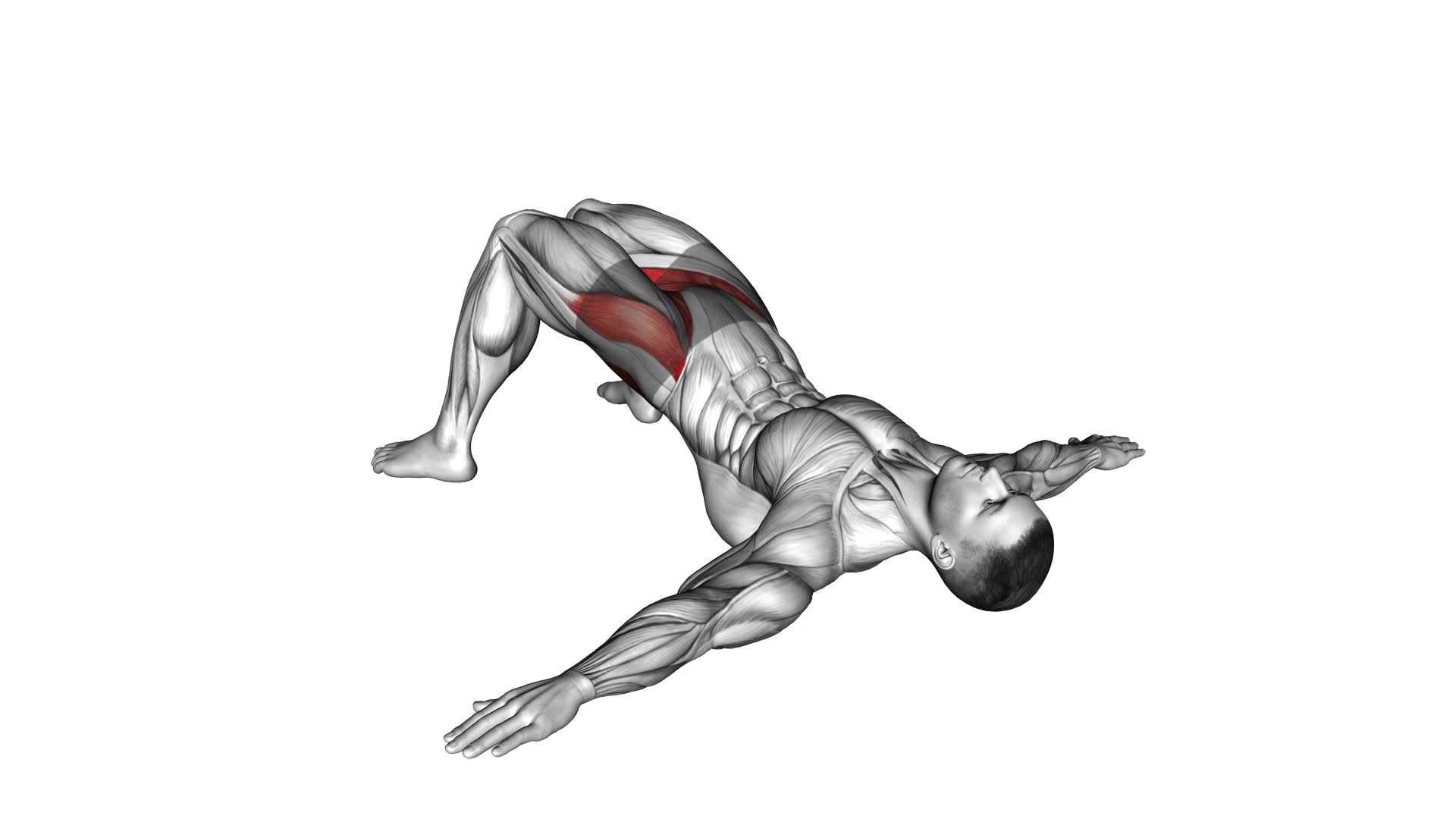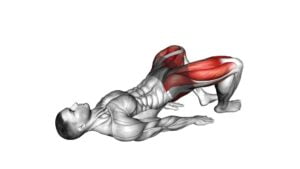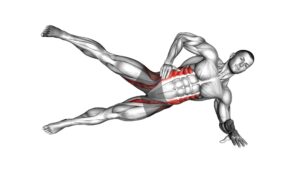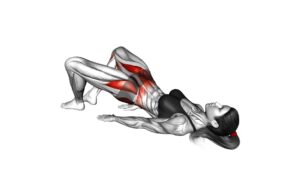Bridge Hip Abduction (male) – Video Exercise Guide & Tips

Are you looking to strengthen your hip muscles and improve your lower body stability?
Watch This Exercise Video
Then Bridge Hip Abduction is the exercise for you!
In this video exercise guide, we'll show you how to properly perform Bridge Hip Abduction, along with variations and progressions to keep challenging yourself.
Avoid common mistakes and maximize the effectiveness of this exercise with our helpful tips.
Get ready to take your fitness to the next level with Bridge Hip Abduction!
Key Takeaways
- Targets muscles in glutes, hips, and thighs
- Increases muscle activation in these areas
- Improves glute strength
- Enhances overall athleticism and performance
Benefits of Bridge Hip Abduction for Men
You should regularly incorporate Bridge Hip Abduction into your workout routine as it offers numerous benefits for men. This exercise, which involves lifting one leg while in a bridge position, targets the muscles in your glutes, hips, and thighs. By incorporating Bridge Hip Abduction into your routine, you can experience increased muscle activation in these areas.
One of the main benefits of Bridge Hip Abduction is improved glute strength. The glute muscles, including the gluteus maximus, medius, and minimus, play a crucial role in stabilizing the pelvis and supporting the hips during various movements. By strengthening these muscles, you can enhance your overall athleticism and performance in other exercises.
Additionally, Bridge Hip Abduction can help to activate and strengthen the hip abductors. These muscles, including the gluteus medius and tensor fasciae latae, are responsible for moving the legs away from the midline of the body. Strengthening these muscles can improve your ability to perform lateral movements, such as side lunges or lateral leg raises.
Incorporating Bridge Hip Abduction into your workout routine can also help to improve your hip stability and prevent injuries. The exercise targets the smaller muscles in the hips, which are often neglected in traditional exercises. By strengthening these muscles, you can enhance your overall stability and reduce the risk of common hip-related injuries.
Proper Form and Technique for Bridge Hip Abduction
To perform Bridge Hip Abduction with proper form and technique, focus on maintaining a stable bridge position while lifting one leg. Here are some tips to help you execute this exercise correctly:
- Start by lying on your back with your knees bent and feet flat on the ground, hip-width apart.
- Engage your core and glutes to lift your hips off the ground, creating a straight line from your shoulders to your knees.
- Keep your pelvis level and avoid tilting to one side as you lift your leg.
- Slowly lift one leg off the ground, leading with your heel, while maintaining the stability of your bridge position.
- Pause at the top of the movement for a brief moment, then lower your leg back down with control.
- Repeat the movement on the other leg, alternating sides.
By following these guidelines, you can ensure that you're performing Bridge Hip Abduction with proper form and technique. This exercise is great for targeting the glute muscles and improving hip stability. It can also help to strengthen the core and improve overall lower body strength.
Now let's move on to the next section to explore some variations and progressions of Bridge Hip Abduction.
Variations and Progressions of Bridge Hip Abduction
To progress the Bridge Hip Abduction exercise and challenge your muscles further, try incorporating different variations and progressions into your routine. By adding variations to this exercise, you can target different muscle groups and increase the intensity of your workout.
One variation you can try is the single-leg bridge hip abduction. Instead of performing the exercise with both legs, lift one leg off the ground and perform the movement with only the other leg. This will require more stability and strength from your glutes and hips.
Another variation is the weighted bridge hip abduction. You can add resistance by placing a dumbbell or a resistance band above your knees while performing the exercise. This will increase the workload on your muscles and help you build strength.
As you progress, you can also try the advanced version of the exercise, which involves performing the bridge hip abduction on an unstable surface, such as a Bosu ball. This will challenge your balance and stability even further.
By incorporating these variations and progressions into your routine, you can continue to challenge your muscles and see further improvements in strength and stability.
Transitioning into the next section, it's important to be mindful of common mistakes to avoid during bridge hip abduction.
Common Mistakes to Avoid During Bridge Hip Abduction
During Bridge Hip Abduction, it's important to be mindful of the following common mistakes to avoid. By avoiding these mistakes and making effective modifications, you can ensure that you're performing the exercise correctly and getting the most out of it:
- Allowing your knees to cave in: One common mistake is letting your knees collapse inward during the abduction movement. This can put unnecessary stress on your knees and lead to injury. To avoid this, focus on keeping your knees in line with your ankles throughout the exercise.
- Arching your lower back: Another mistake to avoid is arching your lower back excessively. This can strain your lower back and take away from the targeted hip abduction movement. Engage your core and keep your spine in a neutral position throughout the exercise.
- Lifting your hips too high: It's important to lift your hips to a comfortable and controlled height during the abduction movement. Avoid lifting your hips too high, as this can shift the focus away from your hip muscles and onto your lower back.
- Rushing through the exercise: Lastly, don't rush through the movement. Take your time and focus on the quality of each rep. This will help you maintain proper form and engage the correct muscles effectively.
Tips for Maximizing the Effectiveness of Bridge Hip Abduction
By implementing these tips, you can enhance the effectiveness of your Bridge Hip Abduction exercise and achieve optimal results. Proper alignment is essential for maximizing the benefits of this exercise.
To ensure proper alignment, lie on your back with your knees bent, feet flat on the ground, and arms by your sides. Keep your feet hip-width apart and align your knees and ankles with your hips. This position will help maintain stability and engage the targeted muscles effectively.
Additionally, incorporating resistance bands into your Bridge Hip Abduction can further intensify the exercise. To do this, place the resistance band around your thighs, just above your knees. As you lift your hips off the ground, press your knees outward against the band. This added resistance will increase the engagement of the hip abductor muscles, making your workout more challenging and effective.
Remember to engage your core throughout the exercise and avoid arching your lower back. This will help maintain proper spinal alignment and prevent any strain on your back muscles. Keep your movements controlled and deliberate, focusing on squeezing your glutes and outer thighs at the top of the movement.
Frequently Asked Questions
How Often Should I Perform Bridge Hip Abduction Exercises in My Workout Routine?
To determine the workout frequency for bridge hip abduction exercises, you need to consider your fitness level and goals. Start by performing this exercise 2-3 times per week.
As you progress, you can gradually increase the frequency to 4-5 times per week. Remember to listen to your body and allow for rest days.
Additionally, you can vary the exercise by adding resistance bands or using different leg positions to challenge your muscles and keep your routine interesting.
Can Women Also Benefit From Doing Bridge Hip Abduction Exercises?
Women can definitely benefit from doing bridge hip abduction exercises. These exercises help to strengthen and tone the muscles in the hips, glutes, and thighs. They can also improve stability and balance.
There are variations of bridge hip abduction exercises that cater to different fitness levels. Beginners can start with basic bridge hip abductions, while more advanced individuals can incorporate resistance bands or weights for added intensity.
Remember to always listen to your body and start at a level that feels comfortable for you.
Is It Normal to Feel Discomfort or Pain in the Lower Back During Bridge Hip Abduction Exercises?
Feeling discomfort or pain in your lower back during bridge hip abduction exercises isn't uncommon. It could be due to improper form or overexertion.
To alleviate this, make sure to engage your core and glute muscles properly. Additionally, consider modifying the exercise by reducing the range of motion or using a resistance band for support.
If the pain persists, it's important to consult with a healthcare professional for further guidance and to prevent any potential injuries.
Are There Any Specific Warm-Up Exercises I Should Do Before Starting Bridge Hip Abduction Workouts?
Before starting bridge hip abduction workouts, it's important to warm up properly. Incorporate dynamic stretches like leg swings and hip circles to loosen up your muscles.
Additionally, consider using a foam roller to target any tight spots in your lower back and hips.
Can Bridge Hip Abduction Exercises Help Improve Sports Performance or Athletic Abilities?
Bridge hip abduction exercises can greatly improve your sports performance and athletic abilities. By targeting the muscles in your hips and glutes, these exercises enhance power and strengthen the muscles necessary for explosive movements.
They also help improve agility by increasing your stability and balance. Incorporating bridge hip abduction workouts into your training routine will give you a competitive edge and help you excel in your chosen sport.
Conclusion
In conclusion, bridge hip abduction is a beneficial exercise for men that targets the hip muscles and helps improve stability and strength. By following proper form and technique, variations, and progressions, you can maximize the effectiveness of this exercise.
Remember to avoid common mistakes and focus on engaging the correct muscles. With consistency and dedication, bridge hip abduction can be a valuable addition to your fitness routine.

Author
Years ago, the spark of my life’s passion ignited in my mind the moment I stepped into the local gym for the first time. The inaugural bead of perspiration, the initial endeavor, the very first surge of endorphins, and a sense of pride that washed over me post-workout marked the beginning of my deep-seated interest in strength sports, fitness, and sports nutrition. This very curiosity blossomed rapidly into a profound fascination, propelling me to earn a Master’s degree in Physical Education from the Academy of Physical Education in Krakow, followed by a Sports Manager diploma from the Jagiellonian University. My journey of growth led me to gain more specialized qualifications, such as being a certified personal trainer with a focus on sports dietetics, a lifeguard, and an instructor for wellness and corrective gymnastics. Theoretical knowledge paired seamlessly with practical experience, reinforcing my belief that the transformation of individuals under my guidance was also a reflection of my personal growth. This belief holds true even today. Each day, I strive to push the boundaries and explore new realms. These realms gently elevate me to greater heights. The unique combination of passion for my field and the continuous quest for growth fuels my drive to break new ground.







